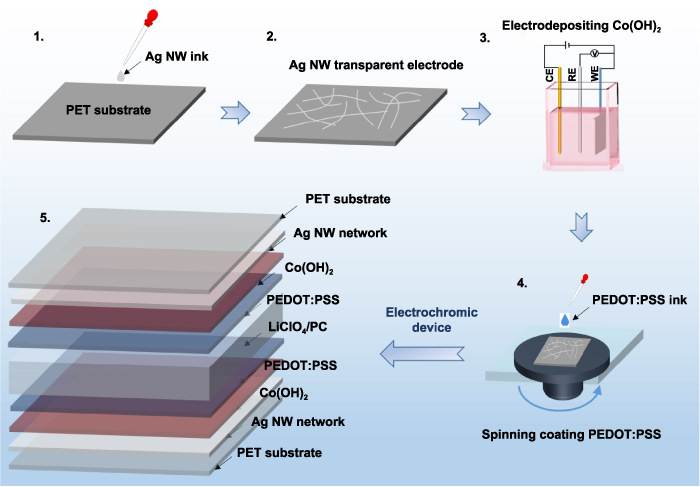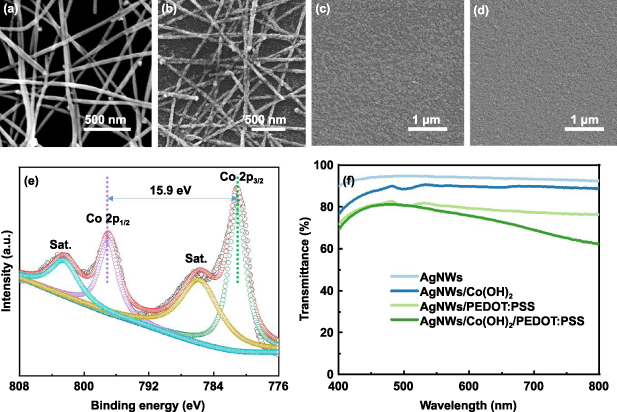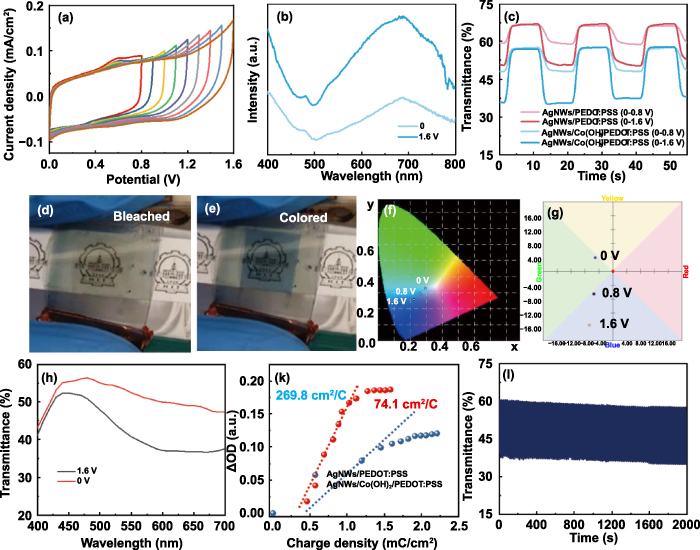Recently, flexible electrochromic energy storage devices (FECESDs) have received a lot of interest as energy sources for powering flexible devices. Silver nanowires (AgNWs) are attractive nanomaterials for use as flexible transparent electrodes (FTEs) in future flexible electronics.

An electrochromic supercapacitor was realized using silver nanowire electrodes as the current collector. PEDOT:PSS was used not only as the functional layer to achieve electrochromic and energy-storage properties at the same time, but also as a protective layer to prevent silver nanowires from electrochemical corrosion. Image Credit: By He Zhang, Fangyuan Sun, Ge Cao, Dongyan Zhou, Guofan Zhang, Jiayun Feng, Shang Wang, Fengyu Su, Yanqing Tian, Yan Jun Liu and Yanhong Tian.
However, the production of FECESDs based on AgNWs FTEs is still hampered by their weak electrolytic stability. A recent study published in the International Journal of Extreme Manufacturing focuses on this issue by creating a hybrid AgNWs FTE consisting of cobalt hydroxide (Co(OH)2) and poly polystyrene sulfonate (PEDOT:PSS).
Electrochemical Energy-Storage Devices: Why Are They Important?
Transparent electrodes (TEs) are used across many applications, such as displays, solar cells, touch screens, and batteries. Among these systems, electrochemical energy-storage devices (EESDs) with extended cyclic durability and high energy density have piqued the interest of researchers and are regarded as promising power sources for future technologies.
Many efforts have been made in recent years to produce bifunctional electrochromic energy-storage devices (ECESDs) due to their combined energy-storage and color-changing characteristics. ECESDs, in contrast to traditional energy storage devices, can display energy levels through color variations.
In addition, the fast expansion of flexible and portable devices has substantially raised the need for flexible ECESDs with strong deformability for powering future wearable electronics.
Challenges Associated with the Fabrication of ECESDs
It is currently challenging to fabricate ECESDs with both flexible design and outstanding electrochromic energy-storage capability due to the delayed development of FTE materials.
ITO is often utilized as a TE substance for ECESDs, but its instability makes it challenging to meet the needs of flexible electronics. In addition, the high manufacturing expenses and restricted indium deposits contribute to the high cost of ITO-based ECESDs.
Various alternatives for ITO have been created, such as conjugated polymers, carbon nanotubes, and graphene. However, these substances demonstrate poor optical and electrical efficiency because of limited inherent conductance.
Among the options now available, AgNW-network-based FTEs with outstanding conductance, excellent transmittance, cheap cost, and solution-processability appear promising as a replacement for ITO.
However, AgNWs have minimal electrolytic stability and are rapidly damaged during anodic electrolytic dissolution. As a result, the color-changing and energy-storage capability of ECESDs are severaly restricted.

SEM images of (a) AgNWs, (b) AgNWs/Co(OH)2, (c) AgNWs/PEDOT:PSS, and (d) AgNWs/Co(OH)2/PEDOT:PSS. (e) XPS spectra of Co element after depositing onto the AgNW network; (f) Transmittance spectra of the four different electrodes: AgNWs, AgNWs/Co(OH)2, AgNWs/PEDOT:PSS, and AgNWs/Co(OH)2/PEDOT:PSS.
Hybrid AgNWs-based FTEs for Fabricating ECESDs
In prior work, the AgNWs/PEDOT:PSS structure was used to create a flexible, transparent-to-blue color-changing electrochromic device. The findings from this previous work demonstrate that FECESDs based on AgNWs/PEDOT:PSS material can be fabricated for powering wearable electronics.
However, practical applications of AgNWs/PEDOT include: PSS ECESDs are currently constrained by insufficient energy storage efficiency. FECESD needs substantial energy storage capability to offer a constant energy supply for electronic devices.
Metal hydroxides with energy-storage and color-changing properties have lately been employed in ECESDs. Nickel hydroxide (Ni(OH)2) nanoparticles placed between the AgNWs and the PEDOT:PSS layer may dramatically increase optoelectronic and energy-storage performance. However, nanoscale Ni(OH)2 particles are usually expensive and need time-consuming preparation techniques.
In this study, the researchers deposited a thin Co(OH)2 film between AgNWs and a PEDOT:PSS layer using a simple electrodepositing approach, eliminating the laborious manufacturing procedures of Ni(OH)2 nanoparticles. A symmetrical FECESD with excellent energy storage, color-changing, and periodic bending capability was also successfully manufactured as a result of the modification.
First author He Zhang explained, "In our work, we use silver nanowires to replace conventional ITO material, and PEDOT:PSS can solve the electrochemical instability problem of silver nanowires."

(a) Electrochemical window and (b) UV–vis absorption spectra of AgNWs/Co(OH)2/PEDOT:PSS FECESD, (c) UV–vis transmittance changes at 683 nm in different voltage ranges. The optical image of (d) beached and (e) colored states of AgNWs/Co(OH)2/PEDOT:PSS FECESD at the bending state. (f), (e) colorimetry of AgNWs/Co(OH)2/PEDOT:PSS FECESD in the colored and bleached states. (h) CA curves. (k) The plot of optical density vs. charge density. (k) The change in optical modulation ranges during the cyclic coloring and bleaching processes.
Important Findings of the Study
The PEDOT:PSS not only increased the electrolytic corrosion resilience of AgNWs but also served as an active layer to actualize color-changing and energy-storage features. The Co(OH)2 interlayer also enhanced the color-changing and energy-storage ability of the ECESDs.
The electrochromic energy storage device built on AgNWs/Co(OH)2/PEDOT:PSS demonstrated high areal capacitance and coloring efficiency. Moreover, the produced FECESDs demonstrated remarkable mechanical deformation durability. The areal capacitance stayed unchanged after 1000 repetitions of cyclic bending with a bending radius of 25 mm.
This study produced a flexible, bifunctional energy storage device that can indicate its energy level by color changes and act as a power source for different wearable devices, such as physiological sensors. These discoveries may have far-reaching implications for the future development of intelligent windows for energy-efficient buildings.
Reference
Zhang, H. et al. (2022). Bifunctional flexible electrochromic energy storage devices based on silver nanowire flexible transparent electrodes. International Journal of Extreme Manufacturing. Available at: https://doi.org/10.1088/2631-7990/aca638
Disclaimer: The views expressed here are those of the author expressed in their private capacity and do not necessarily represent the views of AZoM.com Limited T/A AZoNetwork the owner and operator of this website. This disclaimer forms part of the Terms and conditions of use of this website.